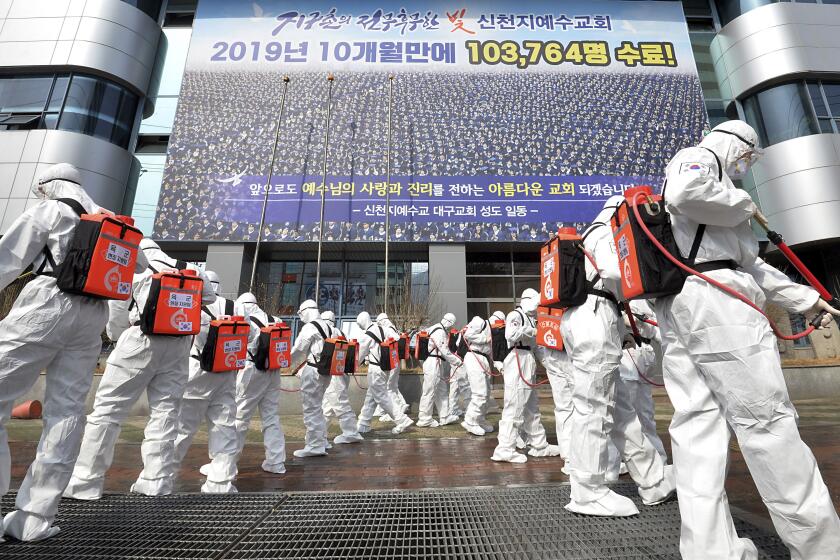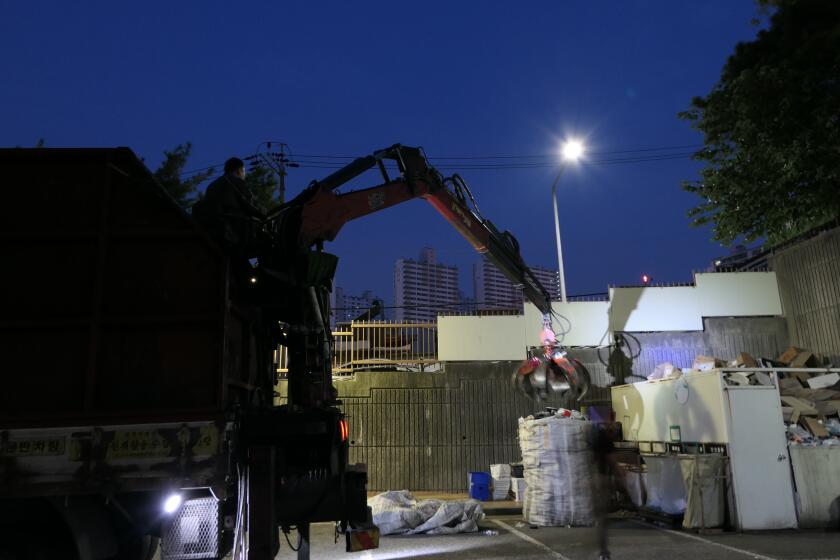South Korean church at center of COVID-19 outbreak urging recovered members to give plasma — even in O.C.
- Share via
About one month into the coronavirus pandemic, Daisy Marquina decided to come home from the San Francisco Bay Area to Santa Ana to be with her family.
San Jose State University — where the senior is majoring in political science — had transitioned to distance learning under California’s shelter-in-place orders, so it seemed an ideal time for Marquina to check on her family and ride out the storm.
“I was going to wait for the pandemic to be over,” she recalled. “I didn’t think it was going to take that long.”
She bunked up in her family’s one-bedroom apartment, already occupied by her parents, younger brother and sister and her older brother, his wife and two kids. Close quarters aside, Marquina describes her Santa Ana apartment complex as a pretty tight-knit community.
“Everybody knows everyone, and we’re all very close,” she said.
Things were going smoothly until May, when Marquina’s family learned a neighbor lady who lived nearby had tested positive for the coronavirus.
Gov. Gavin Newsom on Monday said COVID-19 vaccines could start arriving in limited amounts this year and gave assurances a panel of scientists will independently review anything approved by the FDA.
Within days, nearly all of the nine people living in the small apartment began coming down with symptoms of the virus. Marquina experienced exhaustion and muscle weakness, while her mother had serious breathing problems.
They both spent several days in a COVID-19 unit at Santa Ana’s Orange County Global Medical Center. Back at home, Marquina’s father, younger siblings and niece and nephew exhibited milder symptoms, including headaches and fevers.
That frightful moment led to a voluntary lockdown at Marquina’s family residence. For a full month, everyone in the household self-isolated inside the tiny apartment.
“It’s really hard to quarantine in a one-bedroom apartment with other family members,” the 22-year-old said. “No one got out of bed unless they needed to go to the restroom and even then, we disinfected everything we touched.”
After a close call, Marquina’s mother, a diabetic and the hardest hit by the virus, eventually recovered. Her siblings and father had bounced back and, by mid-June, she herself was beginning to feel better.
But the story doesn’t end there.
Throughout her long illness, Marquina had been bolstered by members of the San Francisco branch of the Shincheonji Church of Jesus, where she’s attended services for nearly two years.
A South Korean religious movement encompassing some 317,000 congregants in multiple nations, the church was thrust into the global spotlight in February when hundreds of its members in the city of Daegu contracted the coronavirus.
Korean religious sect with high coronavirus rate values secrecy
Media reports speculated as to whether the church was a sect whose secrecy contributed to the rapid transmission of the virus among members.
Marquina, however, said church members from her branch and in South Korea provided a valuable lifeline through her long days of self-isolation and even prayed for her live through Zoom.
“They were my emotional support,” she said. “Not only were they always contacting me to see if me and my family were doing fine, they went out of their way to hold prayers for me. Knowing they were doing this for me and my family was really touching.”
So, when she learned Sincheonji members had embarked on a campaign to encourage church members who’d contracted the coronavirus to donate antibody-rich plasma to help COVID-19 patients, Marquina was happy to help.
In August, Marquina contacted the American Red Cross and scheduled an appointment at blood donation center in Santa Ana. In just a few short hours, she’d donated enough plasma to help at least three people.
Dr. Catherine Mazzei, medical director for the Red Cross’ Northern California region, said convalescent plasma is most helpful for people in the beginning stages of COVID-19 disease.
“If we can get you the antibodies early on, before the virus has a chance to multiply and make so many copies, they think that can prevent some of the damage,” she said.
The American Red Cross began testing all blood donations for coronavirus antibodies in June and has found roughly 4.4% contain them. Now, blood centers can extract the antibodies and give them to COVID-19 patients, while keeping red blood cells intact for transfusions.
Mazzei estimated the Red Cross is booking between 500 and 800 donation appointments per day and has so far administered nearly 18,000 units of convalescent plasma nationwide.
“There’s obviously still a need,” Mazzei said. “As soon as we have it, it’s out.”
Having recovered from the virus, Marquina encourages those who’ve recovered from COVID-19 to consider donating plasma.
“I don’t want this to happen to anyone else,” she said. “None of us know how long this will last or when it will end. But there is hope.”
The surge in plastic waste caused by the COVID-19 pandemic may push over the edge an already fragile ecosystem of recycling plastic, already strained by falling oil prices and interruptions in the global trade in recyclables.
In Orange County, health officials on Wednesday reported 262 new infections and 11 deaths, amounting to 57,635 cases and 1,423 deaths so far. About 174 people were being hospitalized for COVID-19, including 66 in intensive care units.
About 1,026,056 tests have been issued countywide, including 15,127 on Wednesday, while the Orange Care Health Care Agency reports a seven-day average testing positivity rate of 3.2%. The average number of new cases per 100,000 residents over a seven-day period stood at 4.6 Wednesday.
Here are the latest cumulative coronavirus case counts and COVID-19 deaths for select cities in Orange County:
- Santa Ana: 11,130 cases; 307 deaths
- Anaheim: 9,869 cases; 309 deaths
- Huntington Beach: 2,531 cases; 84 deaths
- Costa Mesa: 1,960 cases; 44 deaths
- Irvine: 1,814 cases; 13 deaths
- Newport Beach: 1,200 cases; 26 deaths
- Fountain Valley: 549 cases; 19 deaths
- Laguna Beach: 242 cases; fewer than five deaths
Here are the case counts by age group, followed by deaths:
- 0 to 17: 4,242 cases; one death
- 18 to 24: 8,682 cases; five deaths
- 25 to 34: 12,352 cases; 20 deaths
- 35 to 44: 9,182 cases; 38 deaths
- 45 to 54: 9,309 cases; 112 deaths
- 55 to 64: 6,886 cases; 200 deaths
- 65 to 74: 3,461 cases; 279 deaths
- 75 to 84: 1,938 cases; 308 deaths
- 85 and older: 1,535 cases; 460 deaths
Updated figures are posted daily at occovid19.ochealthinfo.com/coronavirus-in-oc. For information on getting tested, visit occovid19.ochealthinfo.com/covid-19-testing.
All the latest on Orange County from Orange County.
Get our free TimesOC newsletter.
You may occasionally receive promotional content from the Daily Pilot.







